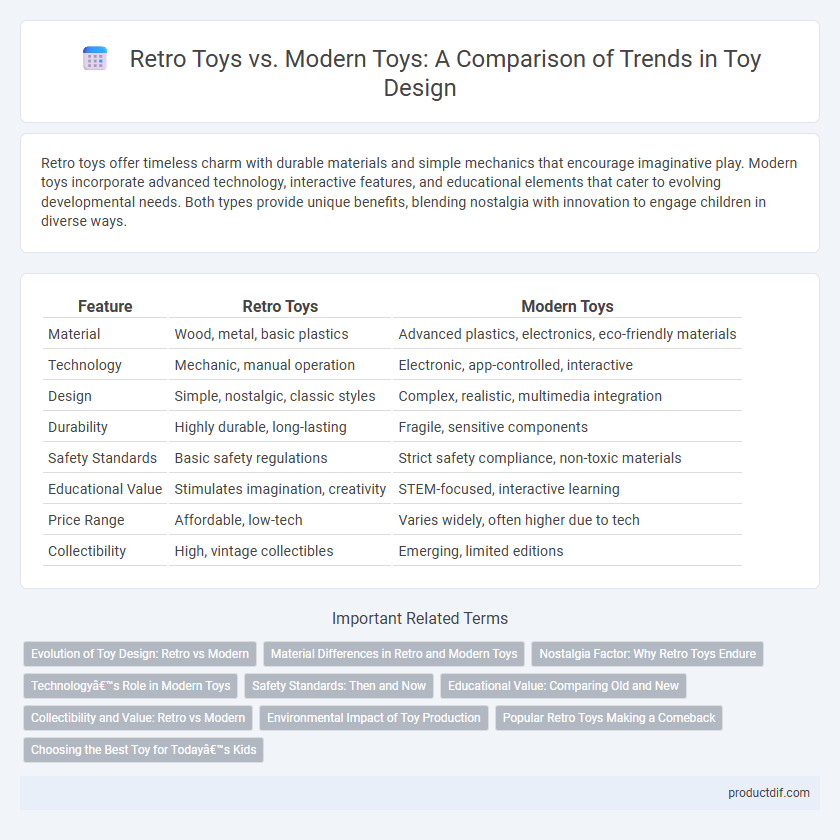Retro toys offer timeless charm with durable materials and simple mechanics that encourage imaginative play. Modern toys incorporate advanced technology, interactive features, and educational elements that cater to evolving developmental needs. Both types provide unique benefits, blending nostalgia with innovation to engage children in diverse ways.
Table of Comparison
| Feature | Retro Toys | Modern Toys |
|---|---|---|
| Material | Wood, metal, basic plastics | Advanced plastics, electronics, eco-friendly materials |
| Technology | Mechanic, manual operation | Electronic, app-controlled, interactive |
| Design | Simple, nostalgic, classic styles | Complex, realistic, multimedia integration |
| Durability | Highly durable, long-lasting | Fragile, sensitive components |
| Safety Standards | Basic safety regulations | Strict safety compliance, non-toxic materials |
| Educational Value | Stimulates imagination, creativity | STEM-focused, interactive learning |
| Price Range | Affordable, low-tech | Varies widely, often higher due to tech |
| Collectibility | High, vintage collectibles | Emerging, limited editions |
Evolution of Toy Design: Retro vs Modern
Retro toys emphasize simple materials like wood and metal with basic mechanical functions, reflecting craftsmanship and durability. Modern toys incorporate advanced technology, including electronics and interactive features, enhancing engagement and educational value. The evolution of toy design highlights a shift from tactile, imaginative play toward multisensory, digital experiences.
Material Differences in Retro and Modern Toys
Retro toys were typically crafted from durable materials like metal, wood, and early plastics such as Bakelite, imparting a heavy, lasting feel often associated with nostalgia. Modern toys predominantly utilize advanced, lightweight plastics like ABS and polyethylene, designed for enhanced safety, flexibility, and intricate detailing. These material advancements in modern toys contribute to increased durability, environmental safety standards compliance, and cost-effective mass production compared to the heavier, more rigid substances of retro counterparts.
Nostalgia Factor: Why Retro Toys Endure
Retro toys endure largely due to their strong nostalgia factor, connecting generations through memories of simpler times and timeless play experiences. These toys often feature classic designs and durable materials that evoke emotional attachment absent in many modern, digital-based toys. Collectors and parents value retro toys for their historical significance and the authenticity of joy they continue to inspire across age groups.
Technology’s Role in Modern Toys
Modern toys integrate advanced technology such as augmented reality, artificial intelligence, and interactive sensors to create immersive and personalized play experiences. Unlike retro toys that rely on simple mechanical functions, contemporary toys often connect to apps and smart devices, enhancing educational value through adaptive learning algorithms. The incorporation of robotics and digital interfaces in modern toys reflects a significant shift towards technology-driven entertainment that fosters creativity and cognitive development.
Safety Standards: Then and Now
Retro toys frequently lacked stringent safety standards, often featuring small parts, sharp edges, and toxic materials that posed hazards to children. Modern toys adhere to rigorous safety regulations such as ASTM F963 and EN71, ensuring non-toxic components, secure construction, and age-appropriate designs. These advancements significantly reduce choking risks, chemical exposure, and injury, providing a safer play experience for today's children.
Educational Value: Comparing Old and New
Retro toys often emphasize imaginative play, fostering creativity and problem-solving skills without relying on screens or digital instructions. Modern toys incorporate advanced technology, offering interactive learning experiences with adaptive feedback that enhance cognitive development and STEM skills. Both types contribute uniquely to educational value, with retro toys promoting foundational social interaction and modern toys advancing technological literacy.
Collectibility and Value: Retro vs Modern
Retro toys often hold higher collectibility and value due to nostalgia, rarity, and limited production runs, attracting serious collectors and investors. Modern toys may gain value if tied to popular franchises or produced in limited editions, but they generally depreciate faster due to mass production. The increasing interest in vintage brands like LEGO, Barbie, and GI Joe illustrates the premium placed on retro toy markets compared to contemporary counterparts.
Environmental Impact of Toy Production
Retro toys often utilized simpler materials like wood and metal, resulting in lower environmental footprints during production. Modern toys frequently rely on plastic components that contribute significantly to pollution and resource depletion in manufacturing processes. Sustainable innovations and biodegradable materials are increasingly being adopted to reduce the environmental impact of contemporary toy production.
Popular Retro Toys Making a Comeback
Popular retro toys such as Tamagotchis, Rubik's Cubes, and LEGO sets are experiencing a significant resurgence in popularity due to their nostalgic appeal and timeless design. These toys combine simple mechanics with engaging play experiences that resonate across generations, attracting both collectors and new users. Retail data reveals a steady increase in sales for retro toy lines, highlighting a growing market trend favoring vintage-inspired products over some high-tech modern alternatives.
Choosing the Best Toy for Today’s Kids
Retro toys often emphasize durability, imaginative play, and nostalgia, providing children with open-ended experiences that foster creativity and social interaction. Modern toys integrate advanced technology such as augmented reality, STEM-based learning, and interactive features that enhance educational value and engagement. Choosing the best toy for today's kids depends on balancing timeless developmental benefits with innovative, skill-building elements tailored to individual interests and learning styles.
Retro toys vs modern toys Infographic

 productdif.com
productdif.com